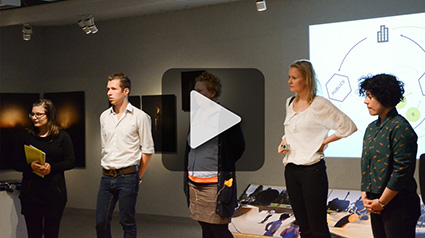Finally we are sharing the final concepts of Design for Government course in video!! The final Show took place on May 28, 2014. If you’re interested in the event itself, see the previous post
1. Shifting Gear (Accessibility Communication)
The team: Nina Isabella Wester, Sasha Kazantsev, Lilli Maaria Mäkelä, Bárbara Paz Rebolledo Bustamante, and Eeva-Maria Piiparinen (first name in italic)
Shifting Gear is a concept proposal that focuses on changing the process of guideline development, opening it up to more active citizen participation. Project aims to assist The Ministry of the Environment in supplying guidelines independently from regulations, that they explain. Provided with the ‘why’ behind the regulations, planners will have a better chance to empathize with the final user.
2. Future Investment (Accessibility Incentives)
The team: Heta Happonen, Anni Inkeri Valkola, Raden Ajeng Sarasati Kushandani Handoyokusumo, Netta Maria Korhonen, and Ningfeng Zhang (first name in italic)
“By 2030, there will be large amount of ageing people and it is more beneficial for them and society that they have the means to live independently.”
Future Investment is an extra saving account that helps people to prepare for future living and housing challenges especially in accessibility. The target is to ensure good and active life by financially preparing for accessibility challenges. By starting the saving program people get mentally prepared for future challenges. Accessibility benefits will be communicated in general fashion in the beginning of the saving program and later in more detail based on current solutions when retirement is getting closer.
3. Kutsuva Kaupunki (Accessibility Implementation)
The team: Philip Hector, Samuli Johannes Räisänen, Krivtsova Anna Igorevna, Maria Andrea Valladares Noguera, Sanna Johanna Laukkanen (first name in italic)
Bringing public places to citizens and citizens to public places. With the ageing population in Finland, the independency of people with different disabilities is an issue now more than ever. Luckily there are a lot of NGOs as well as design solutions supporting accessibility. Yet, what is lacking in the public, is the right mindset – the understanding and awareness of the topic. We created Kutsuva kaupunki, an easy-to-access platform providing information on accessible public places, businesses and services to the citizens. For the companies and service providers, it is a trustworthy source on accessibility. Divided into a digital platform and tangible tools like stickers indicating the accessibility of a place, we hope to raise the public awareness and help society shape itself!
4. Tiesitkö? (Plastic Bags Retail)
The team: Fang-Yi Lee, Salla Irene Seppälä, Aura Kristina Koljonen, Pietro Duchi, Ekaterina “Katja” Ohotnikova (first name in italic)
After pre-research and field observations the team decided to focus on thin plastic bags that are offered in fruits and vegetables departments in supermarkets; he-vi bags (“hedelmät ja vihannekset” bags in Finnish). They are a major part of the plastic bag waste problem as they are single-use product, offered free of charge and used in high volumes that is outside the statistics. We identified two ways of tackling the issue: reduce the use of he-vi bags and promote better alternatives. These can bey done by raising awareness through Tiesitkö campaign, promoting in-store measures and setting legislative or voluntary actions.
5. Oma Kassi (Plastic Bags Littering and recycling)
The team: Harri Max Mikael Homi, Heidi Marjukka Konttinen, Robyn Alexandra Johnston, Amanda Carolin Österlin La Mont, Laura Kristiina Euro (first name in italic)
Oma Kassi (my bag) aims at reducing the use of single use plastic bags. In keeping with governmental wishes, it strives to do this through collaboration between various stakeholders rather than imposing new legislation. Oma Kassi also acts as a conversation tool between stakeholders which inspires them to see opportunities and future scenarios regarding the of reduction of plastic bags.
Oma kassi concept is a long term project, the first implementation is Oma Kassi lane. Oma Kassi lane rewards “own bag users” by making their shopping experience more comfortable in doing so it nudges others to bring their own bag next time.
6. Maybee (Plastic Bags Education)
The team: Jungae Seo, Régis Barreto Frias, Elina Sylvia Hildén, Nanako Tani (first name in italic)
Maybee is similar to any cleaning day (also known as Talkoot in Finland) but with the specific purpose of strengthen community life in one’s neighbourhood with focus on more sustainable life styles. The goal is to make people more aware of waste management problem and reduce use of plastic bag as a consequence of new habits gained through this. We created a toolkit (maybee.fi) to help people get started. The principles behind the idea are: (1) people take care of what they own (“if I helped build it, I’ll help keep it”); (2) an environmentally-minded community works better; and (3) visualising the waste management system lessens the stakeholders’ impact on it.
Client
The Ministry of the Environment
Personnel in chage: Erja Väyrynen (accessible theme) and Tarja-Riitta Blauberg (plastic bags theme)
Experts
Boris Zilberman (independent design ethnographer), Ira Verma (Sotera), Louna Hakkarainen (Users and Innovation research group INUSE), Olga Mashkina (independent researcher, formerly Finnish Environment Institute Syke), Sauli Rouhinen (the Ministry of the Environment), Tuomas Mattila (Finnish Environment Institute Syke)
Contributors
Chelsea Mauldin (Public Policy Lab), Jonathan Veale (Alberta Public Services), Kit Lykketoft (Mind Lab), Marco Steinberg (Snowcone and Haystack, former director of strategic design unit at the Finnish Innovation Fund Sitra), Niina Kilpelä (Kynnys), Outi Kuittinen (Demos Helsinki), Tiina-Kaisa Laakso-Liukkonen (International Design Foundation, Toimiva kaupunki)

